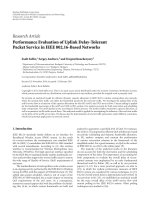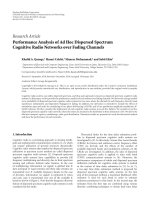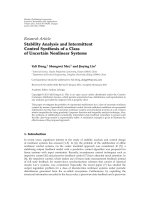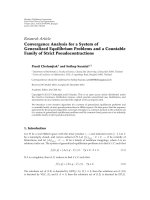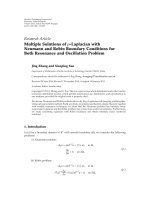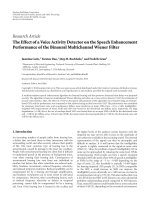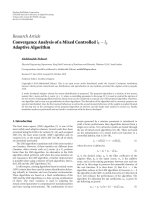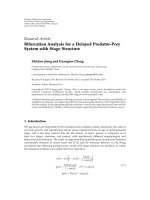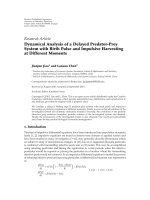Báo cáo hóa học: "Research Article Performance Analysis of Novel Randomly Shifted Certification Authority Authentication Protocol for MANETs" docx
Bạn đang xem bản rút gọn của tài liệu. Xem và tải ngay bản đầy đủ của tài liệu tại đây (767.47 KB, 11 trang )
Hindawi Publishing Corporation
EURASIP Journal on Wireless Communications and Networking
Volume 2009, Article ID 243956, 11 pages
doi:10.1155/2009/243956
Research Article
Performance Analysis of Novel Randomly Shifted Certification
Authorit y Authentication Protocol for MANETs
G. A. Safdar and M. P. O’Neill (nee McLoone)
The Institute of Electronics, Communications and Information Technology (ECIT), Queen’s University of Belfast,
Northern Ireland Science Park, Queen’s Road, Queen’s Island, Belfast BT3 9DT, UK
Correspondence should be addressed to G. A. Safdar,
Received 14 August 2008; Revised 19 March 2009; Accepted 3 June 2009
Recommended by Kameswara Namuduri
The provision of security in mobile ad hoc networks is of paramount importance due to their wireless nature. However, when
conducting research into security protocols for ad hoc networks it is necessary to consider these in the context of the overall
system. For example, communicational delay associated with the underlying MAC layer needs to be taken into account. Nodes
in mobile ad hoc networks must strictly obey the rules of the underlying MAC when transmitting security-related messages
while still maintaining a certain quality of service. In this paper a novel authentication protocol, RASCAAL, is described and
its performance is analysed by investigating both the communicational-related effects of the underlying IEEE 802.11 MAC and
the computational-related effects of the cryptographic algorithms employed. To the best of the authors’ knowledge, RASCAAL
is the first authentication protocol which proposes the concept of dynamically formed short-lived random clusters with no prior
knowledge of the cluster head. The performance analysis demonstrates that the communication losses outweigh the computation
losses with respect to energy and delay. MAC-related communicational effects account for 99% of the total delay and total energy
consumption incurred by the RASCAAL protocol. The results also show that a saving in communicational energy of up to 12.5%
can be achieved by changing the status of the wireless nodes during the course of operation.
Copyright © 2009 G. A. Safdar and M. P. O’Neill (nee McLoone). This is an open access article distributed under the Creative
Commons Attribution License, which permits unrestricted use, distribution, and reproduction in any medium, provided the
original work is properly cited.
1. Introduction
Network security has received critical attention from both
academia and industry in recent years. As data networks scale
and become more pervasive, network intrusion and attacks
have become severe threats to network users [1]. Compared
to their wired counterpart, wireless networks are prone to
security attacks ranging from passive eavesdropping to active
interfering. The open access to the radio interface in wireless
networks exposes the content of communication over the
wireless link between two mobile units, and between mobile
units and the wired network. Such openness also gives an
intruder the option to masquerade as a legitimate user.
The key security requirements of confidentiality, integrity,
authentication and nonrepudiation need to be provided to
offer proper protection to wireless links. In principle these
features can be achieved through robust key management
and cryptographic techniques. Authentication which can
be realized by either public (asymmetric) or private (sym-
metric) key cryptography is of particular importance as it
provides a first line of defense against attacks and forms
the basis for achieving the other security goals of integrity
and confidentiality. An authentication protocol involves a
sequence of message exchanges which verify the identities of
nodes in a distributed system wishing to communicate [2, 3].
A trusted third party (TTP) that is mutually trusted may or
may not be involved as part of the authentication protocol.
Public key cryptography (PKC) has been widely accepted
as an effective mechanism for providing the fundamental
security requirements [4]. It involves a TTP which holds
public key certificates acting as a certification authority (CA).
Much research has been conducted into authentication
techniques for ad hoc networks that distribute the CA func-
tionality to a set of nodes in the network in a process known
as threshold cryptography [5–7]. This method has several
disadvantages such as the compromise of the entire network
2 EURASIP Journal on Wireless Communications and Networking
if the collector node is compromised (collector nodes collect
the partial certificates generated from different server nodes
before generating the complete certificate to be sent), the
lack of network growing rules and the adverse effect on the
ad hoc network life span due to partial certificate collec-
tion and complete certificate generation times. Distributed
CA schemes are also believed to be too computationally
expensive. Identity- (ID-) based cryptography [8], which
eliminates the need for public key certificates and uses
participating node IDs as the public keys, can also be used
to achieve security in ad hoc networks. This method is more
bandwidth efficient than PKC, which requires additional
messages for the distribution and exchange of public keys
before any cryptographic action can take place [9, 10]. In
ID-based systems, a recipient needs a personal secret key
generated by a Private Key Generator (PKG) against the
recipient’s ID to decipher encrypted text. The recipient sends
its ID encrypted with the master public key to the PKG.
The PKG then generates the personal secret key and sends
it to the recipient encrypted with the same master public key.
Since this master public key is generated and sent by the PKG
to all nodes during the setup phase of an ID-based system,
the personal secret key for a particular recipient can also
be retrieved by any other node possessing the master public
key.NodesthemselvescanactasCAstocollectandissue
public key certificates on demand to 1 and 2 hop neighbours
[11], using broadcast messages to establish a chain of trust
across the network. Security in ad hoc networks can also be
achieved by clustering of the network with one predefined
node in each cluster acting as a cluster head, which executes
all administrative functions of the cluster and holds a share
of the network secret (key), used for certification, [12]. Soft
decision processes have also been used in wireless sensor
networks to achieve security by intrusion detection [13].
Unlike authentication, however this is a second line of
defense and is carried out by observing several attacks such
as collisions, unfairness and exhaustion.
Many of the security solutions that have been proposed
for ad hoc networks, such as [5, 10, 12, 14], fail to
consider the underlying Medium Access Control (MAC)
characteristics; the nodes in an ad hoc network need to
strictly obey the rules of the MAC to transmit the security
related messages while still maintaining the necessary quality
of service (QoS). In this research a novel randomly shifted
certification authority authentication protocol (RASCAAL)
[15] has now been developed by taking into account the
constraints of ad hoc networks in addition to the radio tech-
nology MAC related characteristics. The intrusion detection
solution proposed by Ren and Liang [13] does consider the
underlying MAC characteristics, however whereas the focus
of their work is to observe attacks, the RASCAAL protocol
is a first line of defence and aims to prevent attacks through
authentication.
RASCAAL is based on the proven concept of public key
cryptography and provides node authentication by using
ACTIVE CAs, which provide an assurance of a node’s public
key certificate to any other node in the network. RASCAAL
forms dynamic random clusters with no prior knowledge of
the cluster head by a random shift in the role of ACTIVE
CA to any other IDLE CA in the network at the end of
a transaction. This differs from the threshold cryptography
approach and the concept of permanent clusters with
predefined cluster heads. Knowledge of predefined cluster
heads makes the network more vulnerable to attack. The
salient feature of RASCAAL’s security is the very short
life span of a randomly formed dynamic cluster, which is
equivalent to the duration of the current transaction. This
short existence and randomness in cluster formation with no
prior knowledge of the cluster head makes the system robust
and difficult to attack.
The research described in this paper builds on previous
work by the authors in which the security of RASCAAL is
thoroughly analysed using BAN logic [15]. Here the per-
formance of RASCAAL is analysed taking into account the
effects of the underlying MAC. This is necessary in order to
illustrate the effects of security protocols in the context of the
overall wireless ad hoc network. The protocol is implemented
on top of an IEEE 802.11b Carrier Sense Multiple Access with
Collision Avoidance (CSMA/CA) scheme [16] and simulated
using the OPNET Modeller simulation tool [17]. RASCAAL’s
communication and computational delay in addition to its
energy consumption are investigated. The novel RASCAAL
protocol [15] is described in detail in Section 2. Section 3
outlines the simulation setup while a performance analysis
is provided in Section 4. Finally conclusions are discussed in
Section 5.
2. Randomly Shifted Certification Authority
Authentication Protocol (RASCAAL)
RASCAAL has been specifically designed for heterogeneous
ad hoc networks in which some of the nodes have addi-
tional hardware/software resources over other nodes. The
resource enriched nodes with higher buffer and computa-
tional resources can act as CA nodes and the density of
non-CA (resource constrained) nodes in the network will
determine the number of CA nodes required to provide
security services. This results in a linear relationship between
network security and a threshold number of CA nodes
(minimum value 2). A larger number of available CA
nodes results in increased randomness thereby increasing the
security of the network. To start the network activity, any
CA node sensing that the channel is idle for a length of
time equal to the Point Coordination Function interframe
Space (PIFS) can become an ACTIVE CA by transmission
of an ACTIVE
CA MESSAGE. Subsequently, the current
ACTIVE CA randomly selects the ID of a future ACTIVE
CA before this role is shifted by the transmission of
aTRANSFER
CA OWNERSHIP message. The underlying
MAC provides prioritized access to the medium to transmit
an ACTIVE
CA MESSAGE management (or control) frame.
To take control of the medium an ACTIVE CA waits for
PIFS, as compared to other non-CA nodes which wait
for a Distributed Coordination Function interframe Space
(DIFS), where PIFS < DIFS. The ACTIVE CA node engages
in servicing public key certificate requests from other IDLE
CAs(aCAnodewhichhasnotbecomeanACTIVECA
EURASIP Journal on Wireless Communications and Networking 3
yet) and non-CA nodes in the network. In the following
sections, RASCAAL messages have been designed to obey
the underlying IEEE 802.11b frames and MAC requirements.
Ta bl e 1 contains all the notations used in the subsequent
description of the RASCAAL protocol. The assumptions
made to facilitate the analysis of RASCAAL are given as
follows.
(i) The protocol has been developed for heterogeneous
networks in which some nodes are resource enriched
in comparison to other nodes.
(ii) The IDs of all (CA and non-CA) nodes are known
prior to deployment, for example, a small military
network.
(iii) Ideal wireless channel conditions are assumed in
order to avoid any packet loss and retransmissions
(non ideal channel conditions have no direct effect on
the performance analysis of security protocols; how-
ever, they would result in MAC enabled retransmis-
sions due to packet losses, thereby further increasing
the communicational losses).
(iv) The protocol assumes that at least one non-CA node
is always in range of an ACTIVE CA node so that
it can initiate communication with another non-CA
node.
(v) CA and non-CA nodes have synchronized timers
(non-CA nodes can extract time values from the
broadcast messages of the CA nodes to achieve
synchronization for the duration of the randomly
formed cluster).
2.1. RASCAAL (Initialization). As part of initialization,
which provides key management for the protocol, offline
storage of all participating node public keys can be per-
formed. The ACTIVE CA node can transfer the image of
stored public keys to other IDLE CA nodes upon request.
Alternatively, the number of public keys to be stored can
be divided, and keys up to a certain number (depending
on the density of non-CA nodes), can be stored per CA.
On demand transfer of public keys can take place between
both the ACTIVE CA and other IDLE CA nodes employing
multi-hop operation in the network. Additionally, dynamic
key management can take place where nodes can listen for
an ACTIVE
CA MESSAGE, as shown in (1), and upload
their public keys in a SEND
PUBLIC KEY frame, outlined
in (2). Thanks to initialization, RASCAAL does not require
synchronisation of the public key certificates maintained
by the CA nodes. Hashing is employed in the RASCAAL
protocol to provide message integrity. Keyed hashing could
also be utilised to provide authentication of nodes in
addition to message integrity and the associated key could
be stored in both CA and non-CA nodes at the time of
initialization.
Table 1: RASCAAL notations.
Notation
Usage
CA
i
CA node
N
j
Non-CA node
IDCA
i
CA node’s ID
IDN
j
Non-CA node’s ID
T
s
Time stamp value
H
Hash value
PUB
CAi
,PRI
CAi
CA node’s public and private key
PUB
Nj
,PRI
Nj
Non-CA node’s public and private key
E-PUB
Encrypted with public key (CA/non-CA
nodes)
E-PRI
Encrypted with private key (CA/non-CA
nodes)
BCAST
COUNT
Broadcast count value
X
Securely communicated message
Table 2: RASCAAL simulation parameters.
Parameter Value
Slot Time 20 μs
SIFS 10 μs
PIFS Slot
Time + SIFS
DIFS 2
∗ Slot Time + SIFS
Data rate 11Mbps
Layer 2 payload 8000 bits
Simulated time 600 seconds
Message 1: ACTIVE CA MESSAGE:
CA
i
−→ N
(
j···n
)
,CA
(
i
···n
)
:
[
IDCA
i
,IDCA
i−1
,PUB
CAi
, T
s
,BCAST COUNT, H
]
.
(1)
Message 2: SEND
PUBLIC KEY:
N
j
−→ CA
i
:
IDN
j
,PUB
Nj
, T
s
, H
E-PUB
CAi
. (2)
In (1)and(2), T
s
is the time stamp value and H is the
hash of the message for integrity checking. PUB specifies
the public key (CA or non-CA node). In (1), IDCA
i
is
the ID of the current ACTIVE CA to which the ownership
has been transferred from CA
i−1
,thusCA
i
forms the new
cluster for the current transaction. IDLE CA and non-
CA nodes can identify the current ACTIVE CA from the
ACTIVE
CA MESSAGE. BCAST COUNT is incremented
each time the message is rebroadcast by other intermediate
IDLE CA nodes up to a maximum value (usually equal to the
number of CA nodes in the network) to limit the number
of rebroadcasts; all intermediate IDLE CA nodes must
concatenate their IDs in the message before rebroadcasting.
2.2. RASCAAL (Public Key Request/Reply and Secure Trans-
action). At the end of initialization any non-CA node who
wishes to communicate with another node requests the
4 EURASIP Journal on Wireless Communications and Networking
RASCAAL
module
Queue
MAC
module
Sink
Tx
Rx
Feedback from MAC
to RASCAAL module
Channel sensing
Figure 1: RASCAAL node diagram.
Table 3: Performance of encryption algorithm and hash function designs.
Algorithm/hash
functions
Time (μs) Clock speed (KHz) Area (gates) Clock cycles Power (μW) Total energy (nJ)
Encryption algorithms:
Rabin: 512 bits,
0.18 μmCMOS
778 500 21106 389 155 120.6
NtruEncrypt [19]: 167
bits, 0.13 μmCMOS
866 500 16200 — 118.7 102.79
ECC [20]: 134 bits,
0.13 μmCMOS
2.1E05 200 6103 42768 13 2780
HECC [20]: 134 bits,
0.13 μmCMOS
5.4E05 200 7652 109296 17 9290
RSA [22]: 1024 bits,
0.18 μmCMOS
1750 460 — 803822 8.3E05 1.45E06
Hash functions:
SHA-256 [21]: 256 bits,
0.35 μmCMOS
11280 100 10868 1128 8.79 99
SHA-1 [23]: 128 bits,
0.13 μmCMOS
0.00572 500 4276 405 26.73 21.65
MD5 [21]: 128 bits,
0.35 μmCMOS
7120 100 8001 712 4.74 33.75
destination node’s public key from the current ACTIVE CA
in a PUBLIC
KEY REQUEST frame, as outlined in (3). The
protocol assumes that at least one of the non-CA nodes
is in the range of a current ACTIVE CA node so that it
can initiate a secure communication with another non-CA
node. The ACTIVE CA will either have the required public
key certificate itself or can request it from other IDLE CA
nodes and will complete the transaction by transmission of a
PUBLIC KEY REPLY, as shown in (4).
Message 3: PUBLIC
KEY REQUEST:
N
j
−→ CA
i
:
IDN
j
,IDN
j+1
, T
s
,
IDN
j
,IDN
j+1
, T
s
E-PRI
Nj
E-PUB
CAi
.
(3)
Message 4: PUBLIC
KEY REPLY:
CA
i
−→ N
j
:
PUB
Nj+1
, T
s
,IDCA
i
, H
E-PUB
Nj
. (4)
N
j
is the node requesting N
j+1
’s public key and PRI
Nj
is
node N
j
’s private key. N
j
can successfully initiate a secure
transaction with N
j+1
using its public key. A message “X”
can be sent in a SECURE
TRANSACTION MESSAGE, as
described in (5)bynodeN
j
to node N
j+1
in which N
j
also
supplies its public key for two way communication.
Message 5: SECURE
TRANSACTION MESSAGE:
N
j
−→ N
j+1
:
PUBN
j
, T
s
, X
E-PUB N
j+1
. (5)
2.3. RASCAAL (CA Ownership Transfer). At the end of a
successful transaction, the current ACTIVE CA randomly
selects the ID of any other available IDLE CA and shifts the
CA ownership by a TRANSFER
CA OWNERSHIP message,
shown in (6). If there is inactivity in the channel with no
communication between the nodes and any current ACTIVE
CA for a time period of TRANSFER
CA OWNERSHIP
frame+2
∗ max IEEE 802.11 MAC frame, the ACTIVE
CA ownership will still be shifted for increased secu-
rity. The new ACTIVE CA to which the ownership has
EURASIP Journal on Wireless Communications and Networking 5
Transaction time
Active
CA
Active
CA
PIFS PIFS
PUB
REP
PIFS
TRANS
CA
Node
j
DIFS
PUB
REQ
SEC
TRAN
DIFS
Node
j+1
SIFS
ACK
IDLE
CA
i
Neighbourhood
monitoring: In-
range nodes and
IDLE CA nodes over-
hear all the messages
Destination node(s)
All other node(s)
PIFS
Active
CA
Figure 2: Complete transaction time (diagram does not include back off performed by non-CA nodes).
just been transferred announces its CA ownership by an
ACTIVE
CA MESSAGE (1). This results in the formation of
a temporary cluster with a randomly selected cluster head for
a duration equal to the current transaction. The broadcast
nature of the message, and additionally the presence of both
the old ACTIVE CA ID and newly elected ACTIVE CA ID
helps to identify any malicious ACTIVE CAs.
Message 6: TRANSFER
CA OWNERSHIP:
CA
i−1
−→ CA
i
:
[
IDCA
i−1
,IDCA
i
, T
S
,
(
IDCA
i−1
,IDCA
i
, T
s
)
E-PUB
CAi
,BCAST COUNT,H
]
.
(6)
The BCAST
COUNT value is used to limit the number
of rebroadcasts, thus lowering the communicational related
energy consumption of a node. This value is only found in
the messages sent by the CA nodes (ACTIVE and IDLE CA
nodes). The CA ownership transfer message is rebroadcast by
the intermediate IDLE CA nodes with an increment in the
BCAST
COUNT value. The BCAST COUNT value is reset
by the destination node or once it reaches a maximum value
which is equal to the number of available CA nodes in the
network.
2.4. RASCAAL (Node/CA ID Revocation). Both ACTIVE and
IDLE CA nodes have an information base of already associ-
ated nodes and nodes that may potentially join the network.
As such, only valid CA nodes know the other available CA
nodes and the corresponding maximum BCAST
COUNT
value, and therefore, any rogue CA node or malicious activity
can be detected if the BCAST
COUNT value has gone
beyond the maximum value. IDLE CA nodes always con-
catenate their own IDs before doing any rebroadcasting for
increased security and neighbourhood monitoring, which
helps to identify compromised or malicious CA nodes. If any
fake or duplicate non-CA node ID is found, the ACTIVE
6 EURASIP Journal on Wireless Communications and Networking
ACTIVE CA
ACTIVE CA
1: Broadcast of ACTIVE CA MESSAGE
2: PUBLIC KEY REQUEST to ACTIVE CA
3: PUBLIC KEY REPLY from ACTIVE CA
IDLE CA
IDLE CA
1
2
3
4
5
6
7
Previously ACTIVE CA
Previously IDLE CA
6: TRANSFER CA OWNERSHIP from
ACTIVE CA to IDLE CA
7: Broadcast of
ACTIVE CA MESSAGE
IDLE CA becomes
ACTIVE CA
Maximum MAC delay + control packets delay (if successful)
To other IDLE CAs and
non CA nodes in the networ
k
Minimum MAC delay
N
1
, , N
1+j−2
N
1+j−1
, , N
1+j
4 : Secure peer to peer or multi hop
communication (N
j
to N
j+1
)
After ACTIVE CA MESSAGE,
both N
j
and N
j+1
start contending
for the medium again
Both N
j
& N
j+1
contend
for the medium to send
PUPLIC KEY REQUEST
to current ACTIVE CA
NAV for N
j+1
= PUBLIC
KEY REQUEST
time + PIFS
NAV for N
j+1
= PUBLIC
KEY REQUEST
time + DIFS
NAV for N
j+1
=
secure transmissions
time + SIFS
N
j+1
= inhibited from
doing any further
transmissions or backing
off for ACK time + PIFS
NAV for N
j+1
=
transfer packet time
+PIFS
5: ACK from N
j+1
to N
j
Figure 3: RASCAAL message sequence chart.
CA node can access the medium with priority to revoke
that particular node ID in a NODE
ID REVOKE message,
described in (7). Similarly any old ACTIVE CA who has
just shifted the CA ownership or other IDLE CA nodes can
detect and announce a fake CA ID using a CA
ID REVOKE
message, as shown in (8).
Message 7: NODE
ID REVOKE:
CA
i
−→ N
(
j···n
)
,CA
(
i
···n
)
:
IDN
j
,IDCA
i
, T
s
,BCAST COUNT,H
E-PRI
CAi
.
(7)
Message 8: CA
ID REVOKE:
CA
i−1
−→ N
(
j···n
)
,CA
(
i
···n
)
:
[
IDCA
i
,IDCA
i−1
, T
s
,BCAST COUNT,H
]
E-PRI
CAi−1
.
(8)
In (7)and(8), IDN
j
and IDCA
i
are the malicious node and
CA IDs, respectively. Both messages are encrypted with the
private keys of either the ACTIVE CA or the old ACTIVE
CA (which has just shifted the ownership); thus only the
nodes possessing the relevant public key pairs can decrypt
the messages. RASCAAL does not provide provision for the
EURASIP Journal on Wireless Communications and Networking 7
0
1
2
3
4
5
6
7
8
Delay and transaction time (s)
0 100 200 300 400 500 600
Time (s)
Delay
Transaction time
Figure 4: Transaction time versus delay.
0
2
4
6
8
Delay (s)
Rabin NtruEncrypt ECC[20] HECC[20] RSA[22]
Encryption algorithm
Communications only
Computational only
#: SHA-256 [21]
Figure 5: Communicational (average) + computational delay.
redemption of compromised CA nodes, rather a CA node is
declared malicious by revocation (CA
ID REVOKE).
2.5. RASCAAL Security Analysis. An analysis of the RAS-
CAAL protocol using Burrows-Abadi-Needham (BAN) [18]
logic was conducted. Security or cryptographic protocols can
have flaws that enable attackers to influence the protocol
without requiring the appropriate key, or where the crypto-
graphic algorithms used by the protocol can be broken. This
motivates the need for a formal validation of cryptographic
protocols because informal methods are not adequately able
to analyse security flaws. BAN is a formal logic that can
be used to formally describe authentication protocols, and
protocols can be verified by following BAN logic definitions
and postulates. BAN logic defines a series of predicates,
together with mapping instructions for converting message
exchanges into formulas, thereby enabling analysis of the
knowledge and beliefs that peer entities obtain during an
authentication dialogue. A detailed description of the BAN
logic analysis of RASCAAL is presented in previous research
by the authors [15]. This analysis illustrated that RASCAAL
can successfully authenticate nodes and achieves secure
communication between them by assuring the ownership of
0
2
4
6
8
Delay (s)
Rabin NtruEncrypt ECC[20] HECC[20] RSA[22]
Encryption algorithm
Total delay + SHA-256[21]
Total delay + SHA-1[23]
Total delay + MD5[21]
Figure 6: Communicational (average) + computational delay for
different hash functions.
public key certificates. Additionally, the protocol can suc-
cessfully identify and revoke any malicious or rogue nodes.
Confidentiality in RASCAAL is obtained by encryption using
public and private keys and hash values have been employed
where needed to provide integrity. Finally, time stamp values
provide nonrepudiation since all the node timers and timing
values are synchronised with the CA clock.
Even if a malicious CA node copies the ID and
steals the public key of a valid CA node from the
ACTIVE
CA MESSAGE,itcannotbehavenormallybecause
a malicious CA node will not be able to decrypt the
SEND
PUBLIC KEY, PUBLIC KEY REQUEST or TR ANS-
FER
CA OWNERSHIP messages. These messages can only
be decrypted by a valid CA’s corresponding private key
which is only maintained by the valid CA node (loaded
at the initialization stage). Additionally neighbourhood
monitoring can help to distinguish and isolate malicious
CA nodes. All CA nodes concatenate their own IDs when
rebroadcasting and a malicious CA node which has copied
the ID of a valid CA node will not know what other CA nodes
are available in the network and to whom the CA role can be
shifted in the TRANSFER
CA OWNERSHIP message.
3. Simulation Details
Using the OPNET Modeller discrete event simulator tool
[17], RASCAAL was implemented on top of a CSMA/CA
scheme and simulations were performed for an IEEE 802.11b
network consisting of two CA nodes and two non-CA nodes.
This number of CA and non-CA nodes is sufficient to
implement and analyse all the features of RASCAAL. The
main simulation parameters are given in Ta bl e 2.BothCA
and non-CA nodes have independent RASCAAL modules
and a queue to imitate the behaviour of layer 3 and
above, and to generate all the security related messages.
Depending upon the type of packets received by the layer 2
MAC module, the RASCAAL module only generates packets
when invoked by the MAC. The complete node diagram
is shown in Figure 1. The MAC process implemented in
the MAC module of Figure 1 differs for both CA and non-
CA nodes. Compared to non-CA nodes, CA nodes do not
perform any back off and always have prioritized medium
8 EURASIP Journal on Wireless Communications and Networking
1E −07
1E
−04
1E
−01
Energy consumption (Joules)
Rabin NtruEncrypt ECC[20] HECC[20] RSA[22]
Encryption algorithm-total energy consumption
#: SHA-256 [21]
(a) Computational contribution only
1E −01
1E +0
Energy consumption (Joules)
Rabin NtruEncrypt ECC[20] HECC[20] RSA[22]
Encryption algorithm-total energy consumption
Communications only
Computational + SHA-256[21] only
#: SHA-256 [21]
(b) Encryption algorithm—total energy consumption
Figure 7: Communicational (average) + computational energy
consumption.
access. The CSMA/CA MAC model employed with the
RASCAAL protocol utilises a uniform distribution for the
number of back off times and an exponential distribution
for the contention window. The back off timer is uniformly
distributed because the back off value is computed from
a uniform distribution. Additionally, a simulation time of
600 seconds is chosen because the uniform distribution has
settled to a steady state after this length of time.
Since the focus of this research is to analyse the effects
of the underlying MAC on the performance of RASCAAL
and vice versa, simulations were performed assuming ideal
channel conditions. Additionally, our simulations of the
RASCAAL protocol assume that at least one of the non-CA
nodes is in the range of a current ACTIVE CA node to initiate
a secure communication with another non-CA node. Since
wireless ad hoc networks are typically resource constrained,
an investigation was carried out into the communicational
and computational delay and energy consumption overheads
incurred by the RASCAAL protocol. The underlying medium
access control protocol was solely responsible for all the
communicational losses (delay and energy consumption).
The computational overhead was investigated by studying
1E −01
1E +0
Energy consumption (Joules)
Rabin NtruEncrypt ECC[20] HECC[20] RSA[22]
Encryption algorithm
Total energy + SHA-256[21]
Total energy + SHA-1[23]
Total energy + MD5[21]
Figure 8: Communicational (average) + computational energy
consumption for different hash functions.
encryption and hash function hardware architectures that
were previously proposed in literature for use in resource
constrained applications [19–23] and which could be utilised
in conjunction with the RASCAAL protocol. The encryption
and hash function designs utilized in the analysis are sum-
marized in Ta bl e 3. The performance results provided for
Rabin’s scheme are based on current work being conducted
by the authors. Also, it should be noted that the results
presented for the NTRUEncrypt algorithm are for a design
that offers a security level of 76 bits. In February 2009, this
algorithm was approved for standardization by the IEEE at
security levels ranging from 112 bits to 256 bits [24]. To date,
however, published research into the performance analysis of
NTRUEncrypt has focused on a 76-bit security level.
The communicational energy consumption was calcu-
lated by assuming that a station’s operating current was
290 mA for transmitting (Tx), 205 mA for receiving (Rx) and
62 mA for doze or sleep mode (Prism 2.5, 3.3 volts, IEEE
802.11b network interface card). It was then calculated as
P
= V ∗I
To t a l
,(9)
where the total current value, I
To t a l
, is computed for one
complete run of simulation and is given by I
To t a l
= I
Sleep
+
I
Rx
+ I
Tx
.ValuesforI
Sleep
, I
Rx
,andI
Tx
are obtained by
multiplying the total sleep, Rx-On and Tx-On time with
the respective current values given for the specified Prism
network interface card. The “On” time value is computed
by dividing the length of a layer 2 packet by the data-
rate. The overall energy consumption value was obtained
by the summation of communicational and computational
values. Similarly, the overall delay value was the addition
of communicational and computational delay values. All
the delay and energy consumption results are discussed and
analysed in the following section.
4. RASCAAL Performance
Analysis and Discussion
4.1. Transaction Time versus Node Access Delay. The com-
plete transaction time for RASCAAL as illustrated in Figure 2
and described in (10) is the time spent between the
EURASIP Journal on Wireless Communications and Networking 9
transmission of an ACTIVE
CA MESSAGE by the current
ACTIVE CA and a TRANSFER
CA MESSAGE, when the
role of the ACTIVE CA is randomly shifted to any other
IDLE CA available in the network (the ID of an IDLE CA
from the list of available IDs is randomly chosen from a
uniform distribution). A message sequence chart showing
the message exchanges between both non-CA and CA nodes,
and ACTIVE and IDLE CA nodes, is shown in Figure 3.
This chart gives a detailed explanation of the RASCAAL
protocol and illustrates the minimum and maximum MAC
delay incurred by successful and contending non-CA nodes,
respectively. A contending non-CA node incurs maximum
MAC delay due to the very nature of CSMA/CA. It waits by
extracting the value of the Network Allocation Vector (NAV)
from the packets (messages) not destined to itself. A detailed
delay analysis is provided in Section 4.2:
Transaction time
=
[
(
3
∗PIFS
)
+ SIFS +
(
2 ∗ DIFS
)
+
(
ACTIVE
CA MESSAGE
+TRANSFER
CA OWNERSHIP
+ PUBLIC
KEY REPLY
)
+
(
Back off
∗PUBLIC KEY REQUEST
+SECURE
TRANSACTION MESSAGE + ACK
)
]
.
(10)
The average transaction time is 57% less than the average
delay experienced by a node as illustrated in Figure 4,
where the average delay is computed from the values of
minimum MAC delay (successful node) and maximum
MAC delay (unsuccessful contending node) as shown in
Figure 3. Irrespective of the other control/management
packets (messages) used in RASCAAL, the delay value is
computed only for the data packet which is transmitted in
the SECURE
TRANSACTION MESSAGE. This higher value
of delay results because of the higher delay experienced by the
contending node (Figure 3).
The salient feature of RASCAAL’s security is the very
short life span of a randomly formed dynamic cluster, which
is equivalent to the duration of the current transaction. This
short existence and randomness in cluster formation with
no prior knowledge of the cluster head makes the system
robust and difficult to attack. RASCAAL will have numerous
short-lived random clusters formed in the entire life span of
the ad hoc network. In RASCAAL, the ACTIVE CA node
ensures the overall security and verifies the public keys of
the communicating nodes, thus any malicious node trying to
impersonate or track the role of an ACTIVE CA node will
not be successful because the transaction time on average
is 57% less than the average delay value experienced by a
node. Therefore a malicious node will not be able to detect,
transmit or send information on the channel before the role
of the ACTIVE CA is randomly shifted to another unknown
CA to form a new random short-lived cluster. The delay
values in Figure 4 reach steady state since the randomly
generated uniform deviate also reaches steady state.
4.2. Node Access Delay (Communicational + Computa-
tional). Simulations were performed in order to analyse the
effects of MAC-related communicational and cryptographic-
related computational delay on the performance of RAS-
CAAL. The delay values were computed for a data packet
sent in the SECURE
TRANSACTION MESSAGE. Different
encryption and hash algorithms (as outlined in Tab le 3 )
that could be used to provide the cryptographic needs of
the RASCAAL protocol were considered in the simulations.
Figure 5 shows both the communicational delay and the
computational delay experienced by a data packet when
the SHA-256 hash function is considered with different
encryption algorithms. It is evident from Figure 5, that
the security provided by RASCAAL is achieved at the
cost of high communicational delay (average 6.6 seconds,
99.8% of total delay). This delay value could be avoided
if the SECURE
TRANSACTION MESSAGE was transmit-
ted without any prior security-related control/management
messages such as the ACTIVE
CA MESSAGE.However,any
security/authentication protocol will incur a certain value of
MAC-related communicational delay based on the nature
of such protocols. In terms of computational delay, the
elliptic curve-based algorithms produce the largest delays
while the delay associated with the Rabin, NtruEncrypt and
RSA algorithms is negligible. The communicational and
computational delay values for three different hash functions
are outlined in Figure 6. When communicational delay is
considered, there is little difference between the three hash
function selections.
4.3. Energy Consumption (Communicational + Computa-
tional). RASCAAL was also analyzed in relation to its
communicational and computational energy consumption.
As described in Section 3, the communicational energy
consumption was calculated by assuming that a station’s
operating current was 290 mA for transmitting, 205 mA for
receiving and 62 mA for doze or sleep mode (Prism 2.5,
3.3 volts, IEEE 802.11b network interface card). Figure 7(b)
shows the total network energy consumption (average com-
municational plus computational) when the SHA-256 hash
function is considered with different encryption algorithms.
Since the computational energy consumption values are too
small to be visible in Figure 7(b), these are shown separately
in Figure 7(a). It is clear that the communicational energy
consumption is significantly greater than the computational
energy consumption, accounting for 99.9% of the total
energy. Figure 8 also outlines the computational only energy
consumption associated with the different encryption algo-
rithms when the SHA-256 hash function is employed. The
RSA algorithm architecture consumes the most energy of
the algorithms considered while the NtruEncrypt design
consumes the least.
Figure 8 illustrates the communicational and compu-
tational energy consumption for the three different hash
function designs studied. As with power consumption, the
10 EURASIP Journal on Wireless Communications and Networking
contribution of the hash functions is negligible with respect
to the total energy consumption.
4.4. Saving in Energy Consumption (Communicational). The
standard CSMA/CA protocol requires the contending nodes
to always listen to the channel and stay awake for a duration
equivalent to the value of the network allocation vector
(NAV). This results in additional communicational energy
consumption, which is included in the graphs previously
outlined. The average value of energy consumed by the
different encryption algorithms when the SHA-256 hash
function is utilised, is 0.817 Joules, as shown in Figure 7.
If the contending nodes change from an active state of
continuously listening to the channel, to a doze or sleep state
equivalent to the duration of NAV, the communicational
energy consumed is reduced to 0.733 Joules, which results
in an average saving of 10.3% and a maximum saving of
12.5%.
4.5. RASCAAL Overall Performance Discussion. From the
analysis presented in this paper, it is clear that RASCAAL’s
performance suffers principally from communicational-
related delay and energy consumption. However, all authen-
tication protocols proposed for ad hoc networks will incur
these MAC-related overheads which are associated with the
protocol’s control and management messages. In RASCAAL,
there are only three management/control messages prior to a
data packet being transmitted between two nodes. However,
other authentication schemes that have been proposed for
wireless ad hoc networks incur much greater communi-
cational overheads. In threshold cryptography the nodes
wishing to communicate have to firstly transmit the partial
certificate collection requests to the server nodes obeying all
the rules of the underlying MAC. Nodes must then wait and
keep listening to the channel with their receivers on to receive
the replies from the server nodes. It is clear that this will
result in very high delay and energy consumption values.
Additionally the threshold scheme is highly dependent on
routing algorithms to find and route the certificate collection
requests to the server nodes holding a share of the system
secret. ID-based cryptography requires nodes to execute a
numberofalgorithmssuchassetup,encrypt,extractand
execute before they can actually start communication which
will also inevitably result in significant communicational and
computational delay and energy consumption losses.
RASCAAL’s computational delay and energy consump-
tion will be affected by the encryption algorithm and hash
function architectures chosen to perform the cryptographic
requirements of the protocol. Since the nodes in wireless ad
hoc networks are typically resource constrained, the area of
the cryptographic algorithm architecture must be considered
in addition to their delay and energy consumption values.
The cryptographic designs chosen for this investigation
were selected as they were targeted at resource constrained
applications. It is very difficult to compare these architectures
as they are implemented on different technologies and since
they use various key sizes, they offer different security
strengths. However, their purpose is to provide an indication
of the computational delay that is to be expected when cryp-
tographic algorithms, such as those chosen for this study,
are utilized in conjunction with security protocols. With
respect to node delay, the elliptic curve-based cryptographic
encryption algorithm designs are slower in comparison to
the Rabin, NtruEncrypt and RSA architectures. However
when energy consumption is also considered the RSA design
performs poorly. When the area of the different architectures
is taken into account, the area of the Rabin design is 3
times that of the elliptic-based designs. Therefore, overall
the NtruEncrypt and the ECC algorithm design appear
to be the most appropriate encryption functions to use
with the RASCAAL protocol. The effect of different hash
function architectures on the computational delay and
energy consumption figures is almost negligible. However,
when the design area is considered the SHA-1 architecture
has the lowest gate count by approximately 50%. Therefore,
of the hash functions studied, the SHA-1 design would be the
most appropriate for use with RASCAAL.
5. Conclusion
All security or authentication protocols developed for
wireless ad hoc networks have to obey the rules of the
underlying IEEE 802.11 MAC to transmit security-related
messages while still maintaining a certain quality of ser-
vice. However MAC-related communicational effects and
the computational effects of the cryptographic algorithms
employed by protocols significantly affect the performance
of protocols defined at layer two or above for the provision
of security in ad hoc networks. This paper describes a
novel authentication protocol, RASCAAL. Its performance is
analysed by taking into account the effects of MAC-related
communicational and cryptographic-related computational
losses. RASCAAL is the first authentication protocol which
proposes the concept of dynamically formed short-lived
random clusters with no prior knowledge of the cluster
head. To achieve this, RASCAAL implements the idea of
a random ACTIVE CA selection and CA role shift in the
network by integration with the underlying MAC for ad hoc
networks. The performance analysis demonstrates that MAC
related communicational losses contribute significantly to
the total losses incurred by RASCAAL, in comparison to
the cryptographic related computational losses. This research
illustrates that research into security protocols for wireless ad
hoc networks needs to be considered in the context of the
overall system. However, it was found that communicational
energy saving of up to 12.5% can be achieved by changing
the status of the wireless nodes from a receive state to a sleep
or doze state during the course of operation. In determining
the cryptographic-related effects, various encryption and
hash function hardware designs that have been proposed
in literature for use in resource constrained applications,
and which could be used with the RASCAAL protocol,
were studied. Their purpose was to provide an indication
of the computational effects that can be expected when
cryptographic algorithms are utilized in conjunction with
security protocols. From this study, it was found that the
EURASIP Journal on Wireless Communications and Networking 11
NtruEncrypt and ECC encryption algorithms and SHA-1
hash function were particularly suitable for employment
with the RASCAAL protocol.
Future work will involve analysing RASCAAL for an
increased number of wireless CA and non-CA nodes bring-
ing more randomness to the selection of the ACTIVE CA
node. This increase in the density of nodes will require an
investigation into suitable routing protocols that can provide
multi-hop operation between nodes. An implementation
of RASCAAL on top of energy constrained MAC for
sensor networks will also be carried out and a comparison
conducted between the performance of RASCAAL for sensor
andadhocnetworks.
Acknowledgment
The authors wish to thank EPSRC (EP/C006976/1) for
funding this research.
References
[1] J. Kong, P. Zerfos, H. Luo, S. Lu, and L. Zhang, “Providing
robust and ubiquitous security support for mobile ad-hoc
networks,” in Proceedings of the International Conference on
Network Protocols (ICNP ’01), pp. 251–260, 2001.
[2] J. S. Stach, E. K. Park, and Z. Su, “An enhanced authentication
protocol for personal communication systems,” in Proceedings
of the IEEE Workshop on Application-Specific Software Engi-
neering and Technology (ASSET ’98), pp. 128–132, 1998.
[3] A. Aziz and W. Diffie, “Privacy and authentication for wireless
local area networks,” IEEE Personal Communications, vol. 1,
no. 1, pp. 25–31, 1994.
[4] W. Diffie and M. E. Hellman, “New directions in cryptogra-
phy,” IEEE Transactions on Information Theory,vol.22,no.6,
pp. 644–654, 1976.
[5] L. Zhou and Z. J. Haas, “Securing ad hoc networks,” IEEE
Network, vol. 13, no. 6, pp. 24–30, 1999.
[6] H. Lou, P. Zerfos, J. Kong, S. Lu, and L. Zhang, “Self securing
ad hoc wireless networks,” in Proceedings of the 7th IEEE
International Symposium on Computers and Communications
(ISCC ’02), pp. 567–574, 2002.
[7] B. Lehane, L. Doyle, and D. O’Mahony, “Shared RSA key
generation in a mobile ad hoc network,” in Proceedings of
the IEEE Military Communications Conference (MILCOM ’03),
vol. 2, pp. 814–819, 2003.
[8] A. Shamir, “Identity-based cryptosystems and signature
schemes,” in Proceedings of the Conference on Advances in
Cryptology (CRYPTO ’84), vol. 7 of Lecture Notes in Computer
Science, pp. 47–53, 1984.
[9] H. Deng, A. Mukherjee, and D. P. Agrawal, “Threshold and
identity-based key management and authentication for wire-
less ad hoc networks,” in Proceedings of the IEEE International
Conference on Information Technology: Coding Computing
(ITCC ’04), vol. 1, pp. 107–111, 2004.
[10] D. Bonh and M. Franklin, “Identity based encryption from
Weil pairing,” in Advances in Cryptology, vol. 2139 of Lecture
notes in Computer Science, pp. 213–229, Springer, New York,
NY, USA, 2001.
[11] R. Li, J. Li, H. Kameda, and P. Liu, “Localized public-key
management for mobile ad hoc networks,” in Proceedings
of the IEEE Global Telecommunications Conference (GLOBE-
COM ’04) , vol. 2, pp. 1284–1289, 2004.
[12] M. Bechler, H J. Hof, D. Kraft, F. Pahlke, and L. Wolf,
“A cluster-based security architecture for ad hoc networks,”
in Proceedings of the 23rd IEEE Annual Joint Conference of
the IEEE Computer and Communications Societies (INFO-
COM ’04) , vol. 4, pp. 2393–2403, 2004.
[13] Q. Ren and Q. Liang, “Secure media access control (MAC)
in wireless sensor networks: intrusion detections and coun-
termeasures,” in Proceedings of the IEEE International Sympo-
sium on Personal, Indoor and Mobile Radio Communications
(PIMRC ’04), vol. 4, pp. 3025–3029, 2004.
[14] S. Zhu, S. Xu, S. Setia, and S. Jajodia, “LHAP: a lightweight
hop-by-hop authentication protocol for ad-hoc networks,” in
Proceedings of the 23rd International Conference on Distributed
Computing Systems Workshops (ICDCSW ’03), pp. 749–755,
2003.
[15] G. A. Safdar and M. McLoone, “Randomly shifted certification
authority authentication protocol for MANETs,” in Proceed-
ings of the 16th IST Mobile and Wireless Communications
Summit, pp. 1–5, 2007.
[16] ANSI/IEEE STD 802.11, “IEEE 802.11b, Part II, Wireless LAN
Medium Access Control and Physical Layer Specifications,”
1999.
[17] OPNET, “Modeller Documentation-Wireless Module User
Guide,” .
[18] M. Burrows, M. Abadi, and R. Needham, “A logic of authen-
tication,” ACM Transactions on Computer Systems , vol. 8, pp.
18–36, 1990.
[19] G. Gaubatz, J P. Kaps, and B. Sunar, “Public key cryptog-
raphy in sensor networks-revisited,” in Proceedings of the 1st
European Workshop on Security in Ad Hoc and Sensor Networks
(ESAS ’05), pp. 2–18, 2004.
[20] L. Batina, N. Mentens, K. Sakiyama, B. Preneel, and I.
Verbauwhede, “Public-key cryptography on the top of a
needle,” in Proceedings of the IEEE International Symposium on
Circuits and Systems (ISCAS ’07), pp. 1831–1834, 2007.
[21] M. Feldhofer and J. Wolkerstorfer, “Strong crypto for RFID
tags—a comparison of low-power hardware implementa-
tions,” in Proceedings of the IEEE International Symposium on
Circuits and Systems (ISCAS ’07), pp. 1839–1842, 2007.
[22] C. Yeh, E. F. Hsu, K. W. Cheng, J. S. Wang, and N. J. Chang, “An
830 mW, 586 kbps 1024 bit RSA chip design,” in Proceedings
of the Conference on Design, Automation and Test in Europe
(DATE ’06), pp. 24–29, 2006.
[23] J P. Kaps and B. Sunar, “Energy comparison of AES and
SHA-1 for ubiquitous computing,” in Emerging Directions in
Embedded and Ubiquitous Computing, X. Zhou, et al., Ed.,
vol. 4097 of Lecture Notes in Computer Science, pp. 372–381,
Springer, Seoul, Korea, August 2006.
[24] IEEE Std 1363.1-2008, “IEEE Standard specification for public
key cryptographic techniques based on hard problems over
lattices,” pp. C1–C69, 2009.
